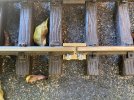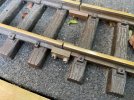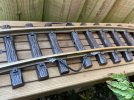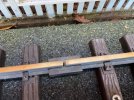Thanks James, your point about connecting the track at each rail joint is something I will follow up. On my own N gauge layout I use multiple feeds around the track, not really a bus a but similar Idea. I will check the Massoth clamp, another new device to me. Robin
You have a few options when it comes to rail joiners. LGB track comes with brass fishplates, I think other brands come with similar joiners. These will work initially, but after a while, in my experience, can become a failure point for good conductivity.
My favoured joiners are the Massoth regular length brass ones

www.massoth.de
I find these very easy to fit and remove if needed as the screw head is facing up, they also provide good rail alignment.

They do a longer one with 4 screws and a shorter one for tight sleeper spacing as well selling them nickel coated
Track Connectors & Co. – Massoth Elektronik GmbH.
Another type is the side screwed clamps - a couple of varieties are shown here.
332 Clamps - gardenrailways.co.uk
Piko do clamps which go straight onto the rail, or larger ones which go over the top of the clamp. Then there is the split jaw type.
I have not tried the split jaw type, but do have some Hillman joiners which are similar to the Piko ones. I find several problems with them. They are tightened by a screw on the side with an Allen head - doing this with an Allen key is slow, if I can get a screwdriver with an Allen head in then it is faster, but that is only possible with good side access to the track. Over time I have found that the Allen heads wear so the driver slips round in the screw head. In the picture below you can see that I've sawed a slot into one of the screws. I also find that these require the rails that are being joined to have exactly the same geometry otherwise the clamp will only grip firmly onto the larger rail - this shouldn't be a problem if you use all the same brand of rail, but I have still encountered it. The split jaw type would not have this issue. That said these also provide good rail alignment.

Finally you can solder across the fishplates. If you are good at soldering rail then this will be the cheapest option - I can do it just about, but don't enjoy it much! The below is a picture of a not very good solder joint...!

Since you are looking at occupancy detection you will also need to use some insulating rail joiners. Again I'd recommend the Massoth ones which are very similar to their regular clamps but made of plastic. An additional bonus is that you can make an electrical connection on both sides of the joiner too.

Piko and LGB sell simple plastic fishplate style joiners which are a lot cheaper than the Massoth ones. However as the rail needs to be slid in you can just undo and straight lift any track up and also I find that they don't hold the rails in alignment very well - fine on a straight, but I'd avoid them on a curve.

So from me the take-away is to use the Massoth joiners. I have a motley collection of solutions gathered over the years, but am now slowly moving to those.





